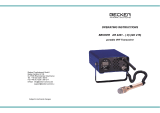
2.6.3.1 Quadrantal error correction
Ground procedure
1. Align the aircraft on the ground with a beacon so that the bearing indicator shows a 0
o
relative
bearing.
2. Set the aircraft directional gyro to 0
o
.
3. Rotate the aircraft to a 45
o
relative heading. The bearing indicator shall indicate 315
o
.
4. Rotate the aircraft to a relative heading of 315
o
.
The bearing indicator shall show a relative bearing of 45
o
.
If the indicated bearing deviates from the set bearing by more than 3
o
when the aircraft is rotated by
45
o
,carry out a Q.E. correction using the trimming resistor.
RMI Converter unit AC3503-() / AC3504-() R79
Converter and indicator unit ID3502-() R60
The variable resistor R60 (ID3502) can be reached through the front panel of the indicator if the top left
attaching bolt of the inner attaching hole circle has not been bolted in.
Flight checking procedure
Due to ground influence or effects from the undercarriage, the quadrantal error correction in flight
can be different from that found on the ground, particularly if the DF antenna is mounted underneath
the fuselage.
1. Align the aircraft on an NDB approximately 60 km away (bearing indicator=0
o
relative bearing).
2 Set the directional gyro to a relative bearing of 0
o
.
3. Fly to a pattern such as described in Fig. 2-1. The total deviation shall not exceed ± 5
o
. The table on
pages 2-7 can be used with this method.
Changes to the quadrantal error correction relative to the ground test can be carried out in flight on the
converter and indication unit using variable resistor R60 or R79 (RMI converter unit).
As described in the ground test, this variable resistor can be reached through the hole for the top left
attaching bolt, provided the bolt is removed before the test flight.
4. Approach the beacon and observe the behavior of the bearing indicator as the beacon is overflown.
The bearing indicator should continuously swing through 90
o
or 270
o
to a back bearing during a
close fly past.
During a direct overflight bad bearings can occur for a certain period depending on the height above the
NDB. These are caused by the cone of silence of the NDB. No reception is possible within this cone of
silence. After the overflight the indicator immediately returns to the set heading.
Page 2-5
Becker Avionics
RA3502-( )
DV 60604.03 Issue 03 April 2020




















